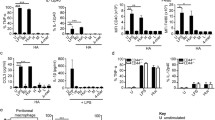Abstract
Hyaluronate of 120,000 molecular weight has been injected in the peritoneal cavity of mice to study its effect on migration of inflammatory cellsin vivo. After one day a dosedependent granulocyte migration is observed. Three days later the number of granulocytes is greatly reduced and macrophages form about half of the total cell population. Hyaluronateelicited macrophages show a decreased 5′-nucleotidase and an increased acid phosphatase activity as compared to resident macrophages. The production of superoxide anion in response to the phorbol ester tetradecanoyl-phorbolacetate, and the phagocytic activity are also enhanced. Macrophages elicited by hyaluronate secrete growth factor(s) for non-lymphoid mesenchymal cells. It is concluded that hyaluronatein vivo stimulates the migration of inflammatory cells, thus causing the recruitment of a population of stimulating macrophages. These effects may explain previous reports on the acceleration of wound healing by hyaluronate.
Similar content being viewed by others
References
J. V. Forrester andE. A. Balazs,Inhibition of phagocytosis by high molecular weight hyaluronate, Immunology40, 435–446 (1980).
J. V. Forrester andP. C. Wilkinson,Inhibition of leukocyte locomotion by hyaluronic acid, J. Cell Sci.48, 315–331 (1981).
E. J. Pisko, R. A. Turner, L. P. Soderstrom, M. Panetti, S. L. Foster andW. J. Treadway,Inhibition of neutrophil phagocytosis and enzyme release by hyaluronic acid, Clin. Exp. Rheumatol.1, 41–44 (1983).
L. Hakansson, R. Hallgren andP. Venge,Regulation of granulocyte function by hyaluronic acid. In vitroand in vivoeffects on phagocytosis, locomotion and metabolism, J. Clin. Invest.66, 298–305 (1980).
T. Ahlgren andC. Jarstrand,Hyaluronic acid enhances phagocytosis of human monocytes in vitro. J. Clin. Immunol.4, 246–249 (1984).
B. T. Shannon, S. H. Love andQ. N. Myrvik,Participation of hyaluronic acid in the macrophage disappearance reaction, Immunol. Commun.9, 357–370 (1980).
T. C. Laurent,Structure of Hyaluronic acid. InChemistry and Molecular Biology of the Intercellular Matrix, 703–732 (Ed.E. A. Balazs) Academic, London 1970.
B. Pessac andV. Defendi,Cell aggregation: role of acid mucopolysaccharides, Science175, 898–900 (1972).
R. L. Goldberg, J. D. Seideman, G. Chi-Rosso andB. P. Toole,Endogenous hyaluronate-cell surface interaction in 3T3 and Simian virus-transformed 3T3 cells, J. Biol. Chem.259, 9440–9446 (1984).
S. H. Love, B. T. Shannon, Q. N. Myrvik andW. S. Lynn,Characterization of macrophage agglutinating factor as a hyaluronic acid-protein complex, J. Reticuloendothel. Soc.25, 269–282 (1979).
G. Abatangelo, M. Martelli andP. Vecchia,Healing of hyaluronic acid-enriched wounds: histological observations, J. Surg. Res.35, 410–416 (1983).
T. K. Hunt, D. R. Knighton, K. K. Thakral, W. H. Goodson andW. S. Andrew,Studies on inflammation and wound healing: angiogenesis and collagen synthesis stimulated in vivoby resident and activated wound macrophages, Surgery96, 48–54 (1984).
B. M. Martin, M. A. Gimbrone, E. R. Unanue andR. S. Cotran,Stimulation of non-lymphoid mesenchymal cell proliferation by a macrophage-derived growth factor, J. Immunol.126, 1510–1515 (1981).
A. Vogel, E. Raines, B. Kariya, M. J. Rivest andR. Ross,Coordinate control of 3T3 cell proliferation by platelet-derived growth factor and plasma components, Proc. Natl. Acad. Sci. USA75, 2810–2814 (1978).
A. Raz, A. Shahar andR. Goldman,Characterization of an in vivoinduced peritoneal macrophage population following intraperitoneal injection of concanavalin, A. J. Reticuloendothel. Soc.22, 445–460 (1977).
M. Sasada, M. J. Pabst andR. B. Johnston,Activation of mouse peritoneal macrophages by lipopolysaccharide alters the kinetic parameters of the superoxide-producing NADPH oxidase, J. Biol. Chem.258, 9631–9635 (1983).
O. H. Lowry, N. J. Rosebrough, A. L. Farr andR. S. Randall,Protein measurement with the folin phenol reagent, J. Biol. Chem.193, 265–275 (1951).
M. L. Karnovsky andJ. K. Lazdins,Biochemical criteria for activated macrophages, J. Immunol.121, 809–813 (1978).
Z. A. Cohn,The activation of mononuclear phagocytes: fact, fancy and future, J. Immunol.121, 813–816 (1978).
G. Berton andS. Gordon,Modulation of macrophage manosyl-specific receptors by cultivation on immobilized zymosan. Effects on superoxide-anion release and phagocytosis, Immunology49, 705–715 (1983).
F. J. Lejeune, A. Vercammen-Grandjean, P. Mendes da Costa, D. Bron andV. Defleur,Suppressor cell induction and reticulendothelial cell activation produced in the mouse by β 1–3 glucan, Adv. Exp. Med. Biol.121, 235–244 (1980).
R. N. Feinberg andD. C. Beebe,Hyaluronate in vasculogenesis, Science220, 1177–1179 (1983).
D. C. West, I. N. Hampson, F. Arnold andS. Kumar,Angiogenesis induced by degradation products of hyaluronic acid, Science228, 1324–1326 (1985).
S. Leibovich andD. Danon,Promotion of wound repair in mice by application of glucan, J. Reticuloendothel. Soc.27, 1–11 (1980).
Author information
Authors and Affiliations
Rights and permissions
About this article
Cite this article
Ponzin, D., Vecchia, P., Toffano, G. et al. Characterization of macrophages elicited by intraperitoneal injection of hyaluronate. Agents and Actions 18, 544–549 (1986). https://doi.org/10.1007/BF01964962
Received:
Accepted:
Issue Date:
DOI: https://doi.org/10.1007/BF01964962




